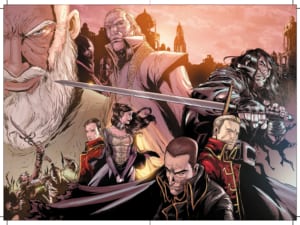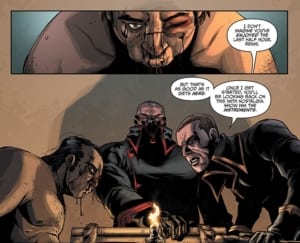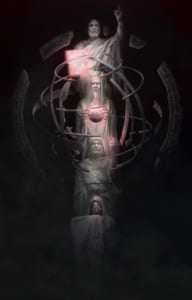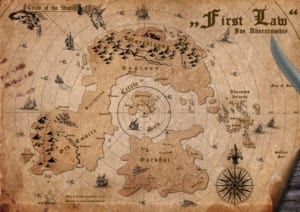As we now hit the 6-year mark on the wait for The Winds of Winter, the latest book in George RR Martin’s A Song of Ice and Fire series, things have become desperate for fans of the series. Some have turned bitter and believe the series will never finish. Others desperately refresh Martin’s Not a Blog hoping to see an announcement. Some have thrown their full support behind Game of Thrones as their finish to the series, regardless of what Martin eventually does. And increasingly, fans have begun to look for alternatives, whether to tide them over until the release of Winds or to move on altogether. The hunt for an alternative is what led me to Joe Abercrombie and his First Law series.
I’m not a fan of Game of Thrones. Few of us here at The Fandomentals are. Dislike for the show is probably how most of us first found Kylie and Julia (though for me it was Legend of Korra recaps). Recent years have been tough for readers that don’t like it, and led us to search for something similar to fill the void. Abercrombie’s name pops up often in that search. Within a year I blazed through the main trilogy of books and its three standalones.
So how does the First Law series serve as a Martin alternative? Really well. For the sake of this comparison I’ll stick to the trilogy, but the standalones are even better.
What Are the Similarities?
ASOIAF is of course famous for its harsh, hard take on a typical fantasy universe and the moral grayness of its characters. Your typical good guys suffer or even die for their crucial mistakes. The “villains” have fleshed out motivations. For the most part, good vs. evil is avoided entirely. Characters act in realistic ways with realistic consequences. Some exceptions exist (freaking Tyrion), but ASOIAF largely provides a fascinating, complicated world.
Abercrombie does much the same, and even better in some ways. Quick overview; these books take place in a familiar medieval setting with major powers in the south, north, and center of the known world. The north is your typical cold, mountainous land inhabited by cruel bearded barbarians. The southern nation, the Gurkish Empire, inhabits desert lands and resembles a Middle Eastern/North African setting. In the center of these two and beset by both is the Union, a heavily European and weakening empire.
Nothing too mindblowing, right?
Well, that’s where Abercrombie so heavily resembles Martin. He excels at taking this typical setup and subverting expectations.
The Union under siege? They’re an entirely corrupt bureaucratic nightmare collapsing under the weight of its ambition, with military command decided by nepotism and nobility rather than capability, and you’ll probably hate everyone you meet there. The northern barbarians follow a charismatic man of little fighting ability who focuses their efforts on defending and developing their country rather than fighting. The Gurkish play every bit the hostile evil foreigner role the novels initially portray them as, but by the end of the trilogy the reasons for their ruthless determination receive much-needed context that strip away a bit of the villainy.
There’s no doubting the Union’s overall role as the protagonists of the story. The Gurkish have a force of cannibals who increase their power with each human they eat (more on the really cool magic later). The Northmen receive support from them. Every main character supports the Union for various reasons. I think Abercrombie makes very clear, however, that they’re no better than those they fight. If you like the moral ambiguity of the conflicts in ASOIAF, you will like the way First Law handles the issue.
The plot itself also resembles something from ASOIAF, with strong twists that catch the reader by surprise but in retrospect were well-seeded. The surprises craft around the characters, rather than the other way around. Seemingly small events and clues from the first book foreshadow game-breaking revelations at the end. Typical fantasy outcomes get subverted in compelling ways. Following the trail of breadcrumbs can lose a reader in details and theories every bit as complex as Martin’s books. Re-reading the series knowing what happens is a real pleasure. If theory crafting is your thing then Abercrombie has you covered here as well.
Politics also play a huge role, which especially becomes apparent by the end. Peasant rebellions, noble struggles, alliance building between nations, secret police, banks, they all play key parts in the story. Even the “gods” of the story (more on them later) function more like all-powerful heads of state than your typical fantasy deity. Few moves are made without at least some consideration of the political consequences involved. So don’t worry about this series lacking the political focus you might love from ASOIAF. If anything First Law probably has more of it.
It’s all really fascinating, but unfortunately Abercrombie does fall into the usual traps of the “realistic” medieval setting. Few women of any real agency exist in the original trilogy, and the women of the standalones uniformly meet the Not Like Other Girls criteria. The endings are almost entirely depressing. Excessive violence, torture, sexual assault, nihilism, everything is present in unfortunate amounts. It might even be enough to drive many people away, even more than the complaints you see about Martin’s books. This extends to the characters as well.
Basically, imagine a book full of Cersei Lannisters. Just about every POV gives her a run for her money in the delusion department.

Possibly more than any series I’ve ever read, the characters of First Law conflict me. On one hand, no one can deny how excellently almost every character in every book is fleshed out and developed. They are easily the strength of the entire series. On the other hand, there may not be a single likeable person anywhere. I’m not exaggerating. I’m trying to think of even one, and there are maybe 2 or 3 that qualify. How big a problem that is depends entirely on the reader. Personally, not liking the characters mattered very little when they were so overwhelmingly compelling and always seemed to take the fantasy formula, turn it upside down, and ram its head into the ground.
The trilogy opens with a Northman named Logen Ninefingers, a humble man with a history of great violence but loathing of fighting, who speaks often to his desire to leave it behind forever and instantly comes across as a good person. He eventually meets with a bald, grandfatherly old wizard named Bayaz, the first disciple of Euz’s son Juvens. Our look at the Union comes from the viewpoint of a handsome and promising young military captain turned secret prince named Jezal dan Luthar and a disabled, highly charismatic war veteran named Glokta who works as a member of the Union’s secret police. Rounding out the cast of main characters are a violent escaped Gurkish slave named Ferro and a soldier of common birth but high potential named Collem West.
Whatever stereotypes or clichés in your head after reading that, go ahead and throw them out the window. The only one you could remotely call a cliché is Ferro, which feeds into the previous complaint about women characters in the series. Even she has her fair share of surprises. These characters think of themselves as the clichés you likely thought of. The kind barbarian, the destined noble, the freedom fighter, the great man of poor origins, and so on. Abercrombie goes to great lengths to tear those delusions apart.
The good, kind, tortured Logen, who constantly tells himself his long years of blood that earned him the nickname “The Bloody-Nine” were the fault of others? You find out just how culpable a part he played in that past. For all his talk of leaving violence behind, the man constantly insists on placing himself in positions where he must fight, and warps his history beyond recognition of truth. The job Abercrombie does building Logen to a certain image and then tearing it apart piece by piece is incredible. These books are worth it for his story alone.
The handsome young Jezal dan Luthar? Talk about a Cersei Lannister. He fully represents the worst of the Union, while believing he represents the best. His confidence vanishes in the face of truly strong personalities. His skill in combat proves entirely false. The woman he loves and believes loves him thinks he is a stupid joke. And I could dedicate an entire article to what happens with Princess Terez.
West thinks himself a better man than his alcoholic father and a representation of the true strength of the common folk. In truth he’s a violent, angry man who beats his sister and murders those he swears to protect. He actually might be the best of these characters from a moral standpoint.
Glokta is the one person who isn’t entirely deluded, but definitely carries an overwhelming self-pity that allows him to make excuses for his horrific career. Rather than Cersei, he matches up with Tyrion Lannister, and the comparisons stand out immediately. Both have disabilities making them societal outcasts. Both have significant intelligence and cleverness which they rely on because of their disabilities. Glokta spends most his time putting himself down and blaming the world for it, just as Tyrion does. Their friends usually consist of mercenary types. Neither has it quite as bad as they tell themselves they do, and have terrible deeds to their names.
Ferro is not deluded at all, though a lot of that has to do with the relative flatness of her character. She is what she is from the very beginning; a tortured, violent woman who has endured many traumas and seeks revenge against the Gurkish Empire responsible for them. We meet her wanting revenge, and she ends the series wanting revenge. The only thing that changes is her capability to get it.
And Bayaz…talking about him without spoiling huge lengths of the series is hard. Let’s just say he’s the biggest liar and hypocrite in the series and it isn’t even close. Grandfatherly is the last way to describe him despite his initial impression. He’s like a certain literary character if he sought a powerful piece of jewelry rather than rejected it.
Not the most likeable characters, I know. What really punches you in the gut are the brief glimpses of their better halves. Where Logen finds a reason to move on from violence, where Ferro finds friendship rather than further desire for revenge, where Jezal matures and grows more capable and Glokta finds respite from his pain and bitterness. When they all regress again, you feel it because Abercrombie does such an incredible job with these characters. He avoids acedia through good writing and strong development.

The secondary characters prove little more likeable. Glokta’s bosses are cruel, vindictive, ladder-climbing jerks. West’s sister Ardee garners considerable sympathy for her circumstances, but spends the majority of her time drunk and making things worse for herself. Kings and queens are terrible, soldiers are cruel and disloyal. Everyone seems to make choices which bring out the worst in them. Even one of the biggest exceptions goes on to live an awful, scarring life in the standalone followups.
Still, Abercrombie wrote a fascinating story in a fascinating world with fascinating, complicated characters very reminiscent of Martin, and it never loses the same surprising, subversive magic that also makes ASOIAF so special.
What Are the Differences?
The first standout is the role of magic, which plays a sizable role in everything (and I mean everything) which happens throughout the series. First Law has a bit of a creation myth, with a half-man half-demon named Euz banishing demons from the world in some ancient time, allowing humanity to flourish. Euz went on to father 4 sons who he taught magic, who then took on disciples of their own. Some of these disciples still live after thousands of years, and play roles of varying importance in the series. It is through these disciples, such as Bayaz, that the majority of traditional magic is seen.
It is also Euz who establishes two Laws meant to restrict the magic his sons and their disciples practiced, including the First Law the series is named for. Basically, all magic traces back to the Other Side, where Euz supposedly banished the demons to. The First Law forbids direct contact with the Other Side. Which is a bit of nonsense since magic itself comes from the Other Side so teaching his sons magic directly contradicted his own laws, as did many of the artifacts they use and that humans use thousands of years later. The Second Law forbids the eating of human flesh, and those who do so are called Eaters. They mostly look human and have increased strength, regenerative abilities, immunity to pain, shapeshifting, and do not age.
Also displaying magical powers are an assorted mix of rarely seen sorceresses, freakish men made of magic back when Euz’s sons lived, and half-demon half-human ancestors capable of feats such as talking to spirits or surviving contact with Other Side artifacts that would kill others. Two of the main characters fall under this category, which is why they become main characters.
As you can see, magic plays a much bigger role in First Law than ASOIAF. However it always remains grounded in the more realistic, low fantasy setting. Magic may be everywhere but few are capable of wielding it or doing much with it if they can.
Very unlike Martin, though, is that the main plot of the trilogy revolves around the conflict between two ancient magic wielders. Imagine if the Great Other and the R’hllor from ASOIAF were real, walking around, and everyone knew it. Where Martin’s story focuses on human beings with mentions of such beings, First Law is all about humans being manipulated by two characters; Bayaz and his rival Khalul. The war between the Gurkish and the Union is just another battle in a war lasting millennia. They fight, rebuild, and fight again. Their magical war is largely political.

That’s not to say human motivation is lost, as the war between Bayaz and Khalul is very much a human conflict based around differing accounts of the death of a son of Euz. So yet again Abercrombie manages to keep the fantastical somewhat grounded in more understandable terms. If ASOIAF appeals to you more than other fantasy because of the diminished role of magic, the First Law trilogy likely won’t chase you away.
What may chase you away is the unrelenting cynicism of the series.
Whatever the reputation Martin and ASOIAF have earned over the years, a romanticism certainly exists to the series. An optimism underlying all the heartbreaking moments. Martin seems, at least to me, to be writing a story not about bad people, but about how hard it is to be good under extreme duress. He wants the reader to feel rewarded when his characters fight to be better despite everything the world does to make them worse. I think that ultimately Martin wants to tell a story where good people prevail. Being good may be hard, but the difficulty makes being good worth it and rewarding.
First Law differs fundamentally from ASOIAF in this regard. It is a hard story about bad people. Even moments presented as a sort of triumph make you sick. When Glokta blackmails a character to sleep with another by threatening her lover, it’s almost supposed to represent a fist-pump moment because of the character’s very understandable actions beforehand. When the final resolution occurs, finding joy in it is basically impossible because of how it happened, the misery involved, and the consequences afterwards.
Rather than tell a tale of good people overcoming the bad in themselves and the world, Abercrombie tells you about some bad people who only briefly glimpse their potential for good before returning to their evil tendencies. And I think it works because this decision is not entirely in their hands. They have the close equivalent of gods directly influencing their lives. Still, this cynicism may be too hard for some fans of ASOIAF to overcome, especially if you take the view of the series I do.
This shows in the general…sameness that you might feel about the characters. Martin provides a vast range of differing personalities to his characters. Differing ages, differing roles in the world, differing thought processes. If you can’t relate to one character, you will find others you probably can. The First Law lacks that same variety. Most the characters have the same views and same category of personality despite some differences in life experience. They can all fight or have at some point. Nobles kind of blend together. It’s far more possible that not relating to a couple of characters means you will struggle to relate to any of them.
There’s also the issue with the lack of important women, which ties directly into that point. ASOIAF is packed with such women. Daenerys, Sansa, Cersei, Arya, Asha, Brienne, Arianne, Margaery, Catelyn, Barbrey Dustin, on and on and on. I probably didn’t list someone that will have you all yelling at me in the comments. The First Law trilogy has no one on the level of any of these characters. Ardee West comes closest, but she’s still little more than a plot device for other characters. Ferro is entirely one-dimensional. This did change with Monza Murcatto and Shy South in the standalone books that followed, two excellent protagonists in their own novels, but the trilogy can be very tough if you need strong women characters in your fantasy.
Why Should You Give It a Shot?
Because frankly, this is the closest thing to ASOIAF in both style and quality you can find. And despite the flaws, First Law is an excellent, if hard to stomach series. The character development is every bit the equal of Martin. The story surprises just the same and does so by ripping apart the expected fantasy tropes. Abercrombie’s world is well-thought out, though not on Martin’s level. A heavy political focus blends seamlessly with the magical for an intriguing version of those same political games ASOIAF became so famous for.
It is not easy to get through. I can imagine many people giving up on the unrelenting cynicism, or disliking the lack of women. You may feel uncomfortable finding no one to root for. I hope you try your best to plow through because it is quite worth it. The First Law may be brutal. Its characters may be unlikeable. The story may not give you a comfortable, satisfying feeling. When it comes to stories similar to ASOIAF, or recent fantasy in general, you won’t find much better.
Images Courtesy of Orbit Books, Blind Ferret, Woodge.com, and Darya Kuznetsova’s DeviantArt page


